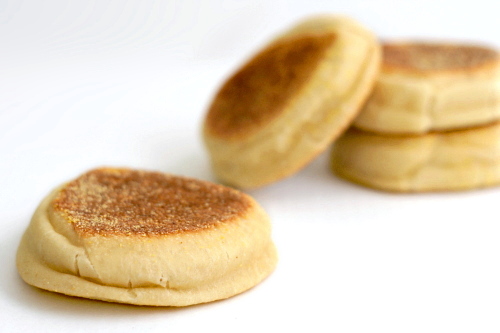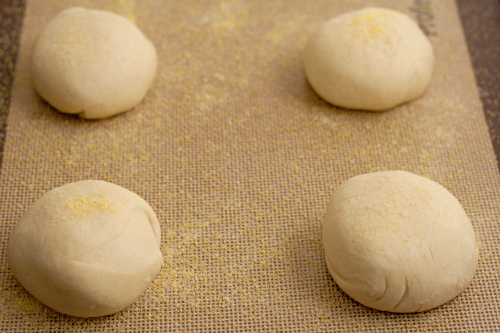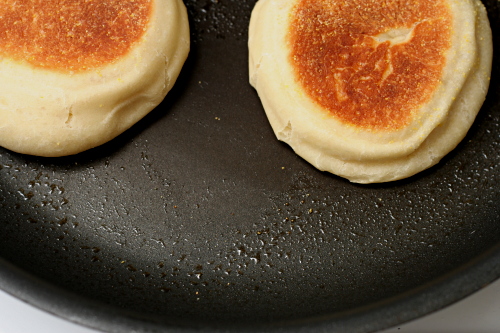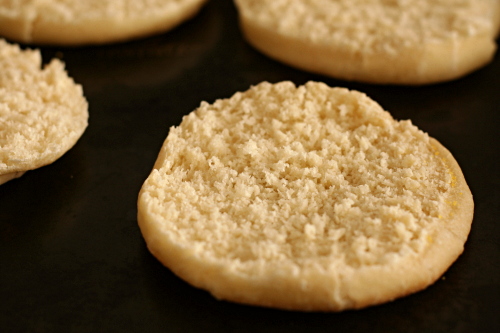I always struggle with how to describe yeast bread dough precisely enough so that someone can reproduce the results I got. Almost every dough is elastic and smooth after kneading, so that doesn’t really help. Sticky and not-sticky are good, but each describes a wide spectrum.
My first inclination is to compare it to a standard sandwich bread. Is it on the more-liquid looser side (like ciabatta), or the more flour-firmer side (like bagels)? That works great for experienced bread bakers, but what about everyone else?
Apparently I’m not the only one with this problem, because Reinhart’s “soft and pliable, not stiff” description didn’t keep me from keeping this dough a little firmer that I think it was supposed to be. He later says that the rounds of dough should “swell both up and out”, which…well, no, that didn’t happen, although they did swell up nicely.
Fortunately, bread is a lot more forgiving than people often think, so just because I had to smoosh my muffins down in the skillet to flatten them doesn’t mean any real harm was done. They weren’t cratered with nooks and crannies as dramatically as I had hoped they’d be, but they will be next time. Because now I know: the dough should be just a bit softer than sandwich dough, but not wet enough to be sticky. Which is very helpful, but only if you know what sandwich bread dough feels like.
One year ago: Cranberry Orange Muffins
Two years ago: Braised White Beans with Potatoes, Zucchini and Tomatoes
Update 3/16/10: I’ve successfully used this method to make these English muffins whole wheat. I made the pre-dough out of 5 ounces whole wheat flour, ¼ teaspoon salt, and ½ cup milk or buttermilk. After letting that sit overnight, I mixed it with the rest of the ingredients – 5 ounces white bread flour, ½ teaspoon salt, 1¼ teaspoons instant yeast, ½ tablespoon granulated sugar, 1 tablespoon shortening or unsalted butter, and ¼ – ½ cup milk or buttermilk.
Printer Friendly Recipe
English Muffins (completely rewritten from Peter Reinhart’s The Bread Baker’s Apprentice, because his recipes are so darn long)
Makes 6
My dough was elastic, supple, and a little soft, but the rolls didn’t expand out so much as just up, so I pressed them down in the pan while they were cooking. This seems to work just fine, although my nooks and crannies were on the small side.
2¼ cups (10 ounces) unbleached bread flour
¾ teaspoon salt
1¼ teaspoons instant yeast
½ tablespoon granulated sugar
1 tablespoon shortening or unsalted butter
¾ to 1 cup milk or buttermilk, at room temperature
cornmeal for dusting
1. Stand mixer: Mix the flour, yeast, salt, and sugar in the bowl of a stand mixer fitted with the dough hook. With the mixer on low speed, add the butter and gradually pour in the milk. Continue mixing on medium-low until the dough is elastic and supple, 8-10 minutes. The dough should be soft, but not sticky.
By hand: Mix the flour, yeast, sugar, and salt in a large bowl. Make a well in the middle of the dry ingredients and pour in the liquid ingredients. Stir the mixture until the dough comes together. Transfer it to a floured board or countertop and knead, incorporating as little flour as possible, for about 10 minutes, until the dough is elastic and supple. The dough should be soft, but not sticky.
2. Transfer the dough to a lightly oiled bowl and cover with plastic wrap or a damp dishtowel. Set the dough aside to rise until it has doubled in volume, about 1 to 1½ hours.
3. Turn the dough out onto a very lightly floured surface. Cut it into six equally-sized pieces and shape each into a ball. Transfer the balls of dough to a baking pan that’s been dusted with cornmeal; sprinkle more cornmeal over the top of the balls and cover with plastic wrap or a damp dishtowel. Set the dough aside to rise for 1 to 1½ hours; the balls will nearly double in size and should swell both up and out.
4. Adjust a rack to the middle position and heat the oven to 350°F. Line a baking sheet with parchment paper or a silicone mat.
5. Spray a large nonstick skillet (or a griddle) with spray oil and heat over medium heat (or 350°F). Place the balls of dough in the skillet with a least 1 inch between them. Cook until the bottoms are very dark brown, just short of burning, 5-8 minutes. Flip the rolls and cook the second side another 5-8 minutes, until it is also dark brown. If, after 5 minutes, the rolls are only golden brown, increase the heat slightly.
6. Transfer the rolls to the prepared pan and immediately bake them for 6 minutes to make sure the center is baked through. Repeat the pan-frying and baking with the remaining rolls.
7. Transfer the English muffins to a wire rack and allow them to cool for at least 30 minutes. For maximum nook-and-cranniness, use a fork to split the rolls instead of slicing them.












I never thought of making my own english muffins . . . what a great idea! Not sure I have the courage to try it though.
They are so cute 🙂 I have yet to make English muffins but I totally want to give it a whirl now.
Thank you for posting the recipe for these English muffins. I’ve always wanted to try this out. I think your muffins look great!
They’re absolutely perfect !!!
Fabulous! They look wonderful!
I have to try these, but was just wondering about the “by hand” directions of step one: is that bit about the pumpkin and eggs a bit of copy/paste gone wrong?
I do love the dough description, for novices it is great to know what to look for.
I really have to try making them. They look easy to prepare. You did a great job.
Amanda – Ack! Thanks for pointing that out!
You make it look so easy!
I have been looking for an English muffin recipe in which I can substitute spelt flour. I will definitely be trying this one. Thanks.
i used to work in a restaurant where we made our own english muffins for sunday brunch service. man, fresh homemade english muffins are so good! i have this book, so i’ll have to try his recipe out sometime!
For the record, I prefer crannies to nooks. They’re just… sexier.
Hi Bridget,
I have a few questions before I tackle these!
First, can you use AP flour or does it have to be bread flour? Do you dust with cornmeal before or after pan-frying?
Also, to have these ready for breakfast do you think you could do the first rise overnight in the fridge?
Thanks for your help!
lbrookscooks – I haven’t tried it myself, but it seems to me that all-purpose flour would be fine. Hm…apparently I left out the part of the recipe that deals with the cornmeal. I’ll correct that now.
I play with rising times and temperatures all the time, so I’d probably be comfortable letting them do the second rise in the fridge. Just be prepared to be a little flexible in the morning, in case they haven’t risen enough; you may need to give them a little more time to warm up and finish rising. If this is the case, I’d probably be impatient enough to put them into a 200-degree oven for a few minutes to speed up the process.
Thanks for getting back to me – I can’t wait to make these.
Hi There! I made these using your whole-wheat variation and they turned out great (in fact, I used whole wheat bread flour instead of regular too, as I was looking for a 100% ww variety). I actually made the pre-dough one night, the dough the following night, and the muffins the day after that. I have a warm kitchen so it really didn’t take that long for them to rise after cutting them out, and the cold dough seemed a little easier to work with. I’ve been serving them as the “bun” for my veggie burgers and they’re great. thank you!
When does the butter get added to the dough, and should it be melted or just soft? Also, my store only has dry active yeast. Do you know if it will also work in lieu of instant yeast? Thank you!
Sasha – The butter gets added right before the milk (step 1). It should be softened but not melted. You can definitely use dry active yeast instead of instant. Just mix the yeast into the milk instead of the flour. It’ll dissolve in the milk and then it can react with the dough.